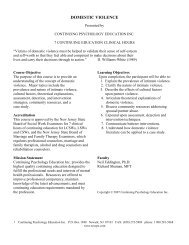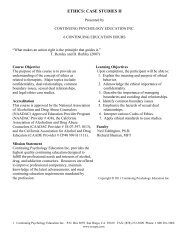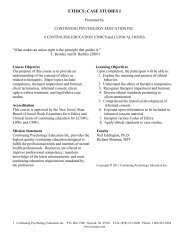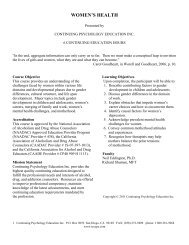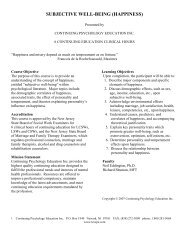FAMOUS THERAPIST ERRORS - Continuing Psychology Education
FAMOUS THERAPIST ERRORS - Continuing Psychology Education
FAMOUS THERAPIST ERRORS - Continuing Psychology Education
You also want an ePaper? Increase the reach of your titles
YUMPU automatically turns print PDFs into web optimized ePapers that Google loves.
<strong>FAMOUS</strong> <strong>THERAPIST</strong> <strong>ERRORS</strong>can even kill us. But over time, if we live long enough, theycan become pearls of wisdom.”LEARNING FROM THERAPY FAILURELiterature on the subject of therapy failure suggests thatrarely does one specific reason to which we attributeunsuccessful therapy explain the entire truth. Deducingcauses of failure is difficult because clients may not knowwhy they felt dissatisfied or given such awareness they oftenkeep reticent over the reason for leaving treatment. Further,therapists may lower their own cognitive dissonance overlosing a client by clouding the issue in order to appearcompetent, denying mistakes, and avoiding selfresponsibilityfor negative outcomes. Finally, the manycomplexities of the therapeutic encounter itself imply that anumber of variables are involved rather than just one factor.The most pervasive variables in therapy failure, whetheralone or in combination, are categorized into factorsattributed to client, therapist behavior, interactive effectsbetween therapist and client, and sabotaging influencesoutside of therapy.CLIENT FACTORSMost often, clients terminate therapy because of therapistactions or inactions, but in some cases, regardless ofcounselor competency, clients may be determined to avoidimprovement. They may unconsciously be driven tosabotage progress or to defy efforts of the most skilledcounselor, hence, some people may never succeed in therapy.Certain personality and mood disorders, various defensemechanisms, and people with impaired judgment or insightare concerns limiting treatment potential – progress in thesesituations may be measured in decades rather than weeks.Greenspan & Kulish (1985) found that clients whosuddenly end their therapy before work has been completedhave a tendency to be young adults, a minority groupmember, have insurance coverage with maximum benefits,have been referred by another professional in a clinic facility,and have situational, acute, or adjustment reactions that theyblame on external factors beyond their control. Colson,Lewis, and Horwitz (1985) determined that individuals inpsychoanalytic treatment with higher chronicity of symptomsand degree of disturbance revealed poor prognosis predictors.Clients who display any of these traits are less likely toimprove in therapy: poor impulse-control, lack social supportsystems, are older, lack sense of humor, are impatient, haveborderline personality disorder, tend to externalize and lackpsychological sophistication (Stone, 1985). It is advised thatcounselors not be pessimistic when dealing with issues ofpoor prognosis in the literature because that would contributeto a self-fulfilling prophecy, rather, to remain optimisticwhile being realistic regarding that which is within our powerto change. Therapists need not avoid or fear high-risk casesbecause often treatment success correlates with client’smotivation, personality, and attitude, in turn, client’s failure12 <strong>Continuing</strong> <strong>Psychology</strong> <strong>Education</strong> Inc.is not automatically the therapist’s failure. Despite thisinformation suggesting that there are some people thatnobody can help, the preponderance of therapy failure is dueto other causes.Research indicates that clients present with a broad rangeof combinations of goals, instead of single or isolated goals,of which symptom relief represents only a small percentageof all possible goals (Connolly & Strupp, 1996; Grosse-Holtforth & Grawe, 2002; Grosse-Holtforth et al., 2004;Hasler et al., 2004; Uebelacker et al., 2005). These studiesalso reveal that treatment goals are only partly associatedwith client diagnosis, hence, therapists cannot assume theyknow client’s treatment goals solely based on diagnosis.Symptom relief appears to be the most important clientreported goal across clinical settings but it is not the mostfrequently indicated goal. Other commonly reported clientgoals include interpersonal problems, personal growth, andexistential issues (Hasler et al., 2004; Holtforth et al., 2004).Hasler et al. (2004), for example, found that clients withpersonality disorders and adjustment disorders did notinclude symptom relief as their most important desiredchange, and Uebelacker et al. (2005) determined thatdepressed clients indicated psychosocial functioning wasequally important a goal as symptom relief. Further, certainclient variables, such as employment status, affect preferredclient goals. Hasler et al. (2004) discovered that unemployedclients reported more social support goals than employedclients. These studies infer that various client characteristicsinfluence their treatment goal preferences.Gross-Holtforth & Grawe (2002, p. 79) define treatmentgoals as “intended changes of behavior and experience thatpatient and therapist agree on at the beginning ofpsychotherapy and on which successful psychotherapyshould be instrumental.” Establishing realistic and beneficialtreatment goals is deemed clinically important because theydirect patient participation and therapist interventions (Long,2001; Tryon & Winograd, 2002). Eliciting active clientparticipation in the development of treatment goals has beenfound to increase commitment to goals and the probability ofgoal-attainment (Locke & Latham, 2002).<strong>THERAPIST</strong> FACTORSAnalysis of treatment failures in family therapy ledColeman (1985) to observe the following most commontherapist causal factors:1) Failure to comprehend the true nature of the presentingproblem and the circumstances surrounding the referral.2) Insufficient bond with family members or a weaktherapeutic relationship with client.3) Theoretical omissions or inconsistent interventions.4) Waning energy.Coleman concluded that failures were not caused byconscious or unconscious errors as much as therapists beingsurprised by “unforeseen entanglements.”Within a psychodynamic treatment process, H. S. Streanconcludes that failures generally occur when therapist is not



